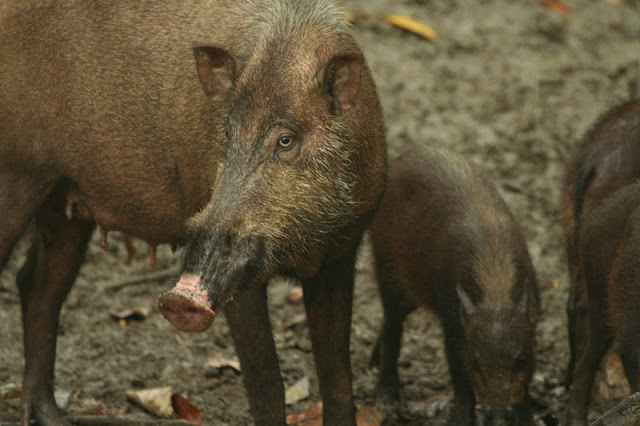There are a number of camps and lodges along the Kinabatangan River, around the villages of Bilit and Sukau, all of which offer excursions on the river by boat. KJC has a particularly good reputation as THE place to stay to see the Cuckoo and the Cat, with the guides knowing the right creeks up the river to try for these two highly sought after and, apparently, very shy species. Judging by what little I saw of the other lodges and their boats, we definitely chose the right place: no where else seemed to have quite as good a position, in terms of being right in the forest, and ours was one of only two boats I saw with just two passengers: our excursions were entirely based on our priorities, rather than being standard general tourist trips.
The rooms were pretty basic, but any shortcomings were more than made up for by the location of the camp: surrounded by floodplain forest, with some of the best sightings right on the doorstep.
We arrived late morning and were greeted by the manager, Fida, who showed us around and mentioned that 'we've heard the cuckoo calling not far away this week'. With a couple of hours before lunch, having dumped bags in the room, we decided to have a quick explore of the camp surroundings.
Just by the main lodge dining room, we stepped onto the trail. I thought we should check to see what the mythical Ground Cuckoo sounded like, so span the ipod to the appropriate call (thanks to xenocanto) and pressed play... 5 seconds of the 'cooing' song, and amazingly a long, dark bird immediately jumped up onto a low branch about 5 metres in front of us: a large-bodied, almost pheasant-like bird, with a sturdy bill and pale skin around the eye on an otherwise black head, dark body with barring underneath: a Bornean Ground Cuckoo. A squawk, an odd shrug of the shoulders, and as quickly he dropped back down out of sight. People come to Kinabatangan and spend days out in the boats, exploring the muddy creeks for a glimpse of a Bornean Ground Cuckoo, and we'd found it virtually within sight of our cabin, within 10 minutes of arriving. Amazing. We walked the trail, hearing a pair of cuckoos calling all the time. Back at the camp, sitting on the steps to our cabin, and we could still hear the cuckoo's cooing. So I walked back to the start of the trail, and there he was, stood out in the open, on the trail: a purple sheen to his greeny-grey back shining in the sunlight. A beautifully awkward looking bird, with a spooked look on his face, reminding me totally of Kevin, the bird from the Pixar movie Up! He ran along the trail, stopping mid-run to look over his shoulder, made that odd shoulder shrug again, squawked his squawk and ducked down to run behind a tree, and out of sight.
On the same trail, we had a female Orang Utan in a tree. A group of Long-tailed Macaques moved past, something she wasn't at all keen on, and then she continued to take her bad mood out on us, taking exception to our presence on the trail: lip smacking, grunting, tearing at ferns and throwing big chunks down at us. While we stood quietly, a little bit in awe of the display, she shifted her position, grabbed at a nearby tree top and, with a twist of the wrist, sent a massive chunk of trunk smashing down towards us: enough falling wood to do serious damage if we'd been a few metres further along the trail. We backed off...
Over the three days we were here, we saw Orang Utan near the camp every day. One day, as we ate lunch with a rain shower going on, a big female joined us in a nearby tree, snacking on the wet vegetation.
As well as the Orang Utan and a regular troop of Macaques, constant visitors to the camp were several families of Bearded Pigs, and some impressively large Water Monitors. The regular Bornean Gibbon unfortunately didn't put in an appearance, and we were out on the boats on the occasions when the semi-resident Storm's Stork and Malay Civet each came to visit.
Along the river, troops of Proboscis Monkeys were a common sight, feeding in the riverside trees or huddling up for the night. The biggest group we came across was 36 animals, all hunkered down for the night in a single tree, glowing orange in the late afternoon light: Proboscis Monkeys go to bed early, presumably to digest the toxic leaves that are their primary diet.
At the other end of the day, Storm's Stork (below) were a regular sight at dawn, in the tops of some of the taller trees. We also found a pair of Lesser Adjutant one morning, as well as a calling Hooded Pitta, Chestnut-necklaced Partridge, Malaysian Blue Flycatcher and White-breasted Babbler. Our night trip wasn't a great success: no cats, unfortunately, but a Reticulated Python and four or five Buffy Fish Owls were good to see.
Black Hornbill
Black-and-Red Broadbill, a riverine forest specialist










No comments:
Post a Comment